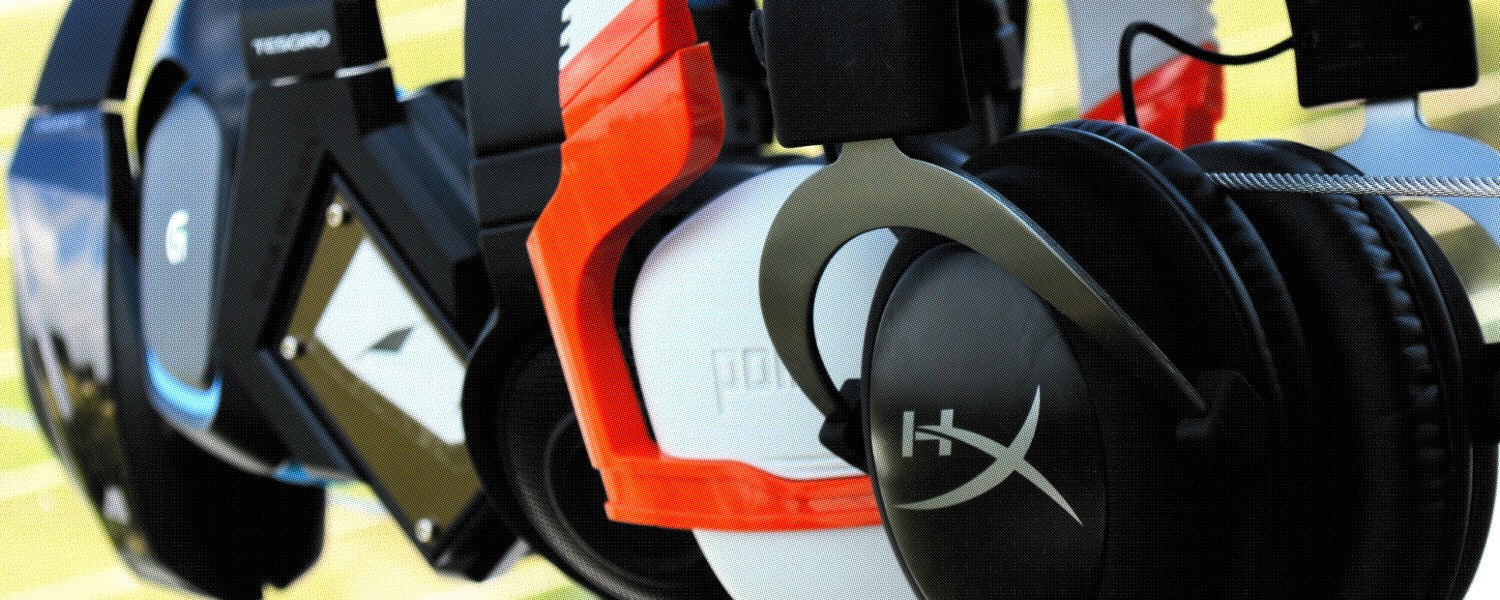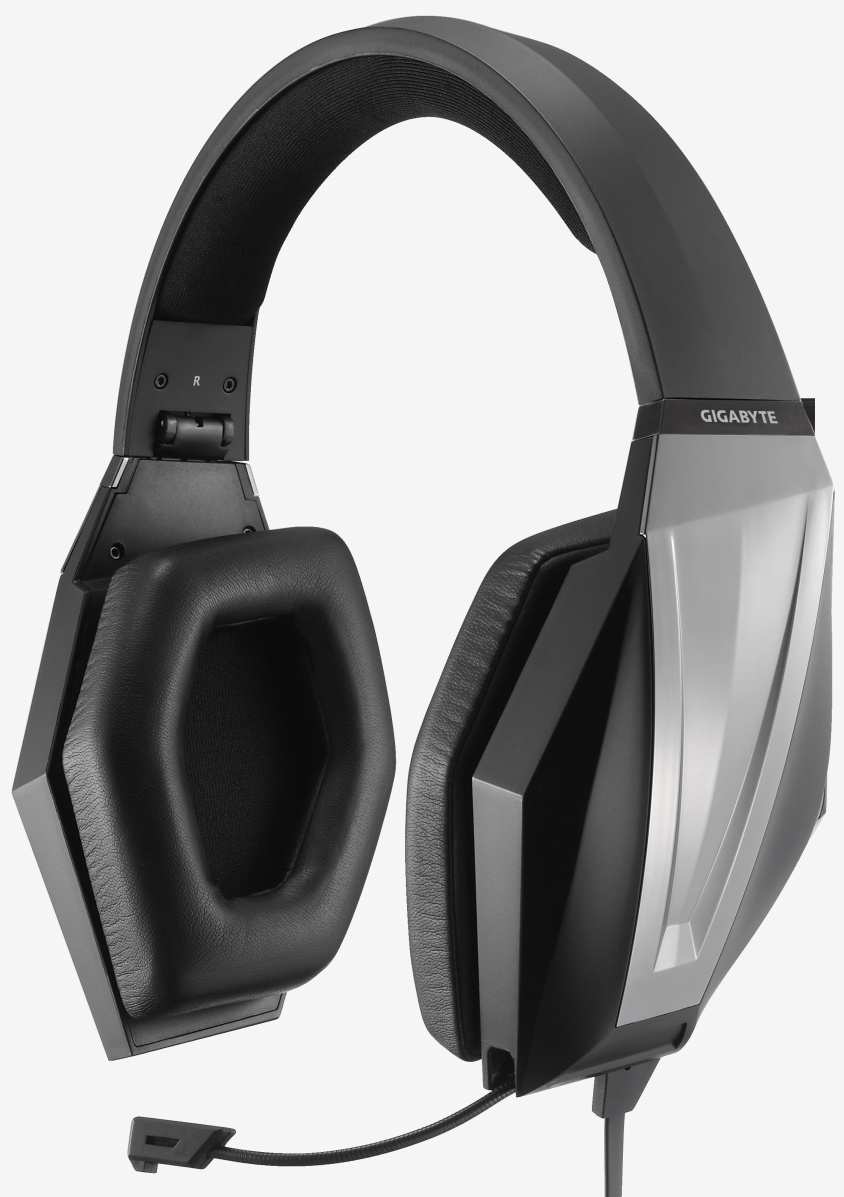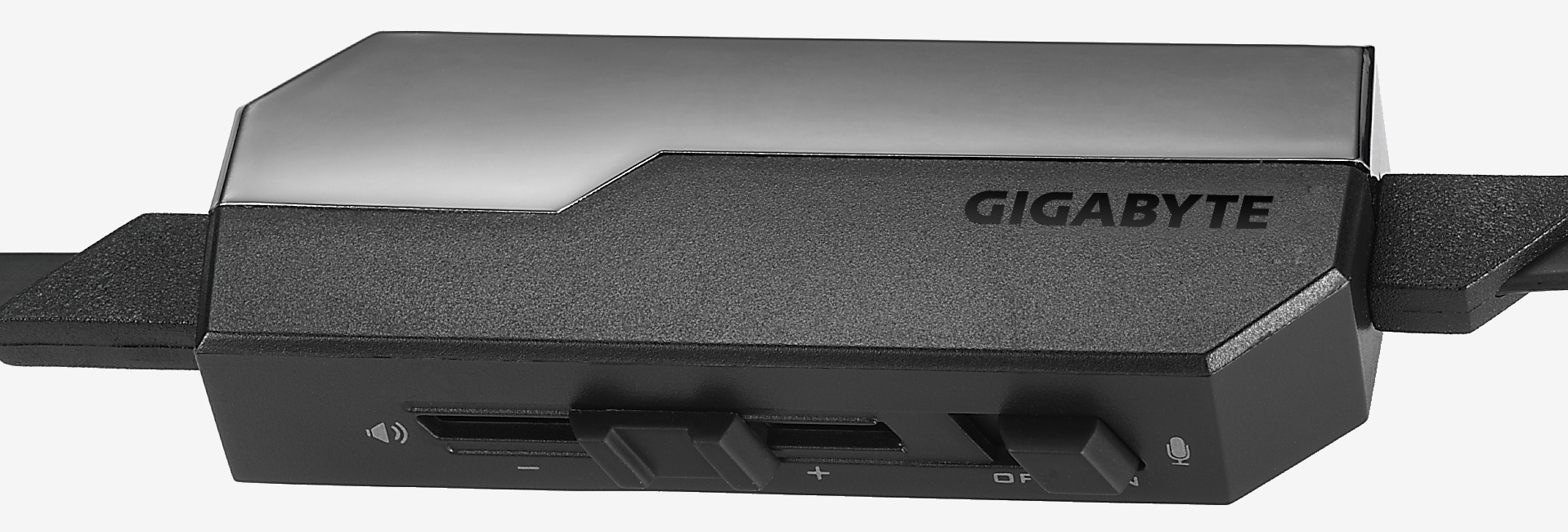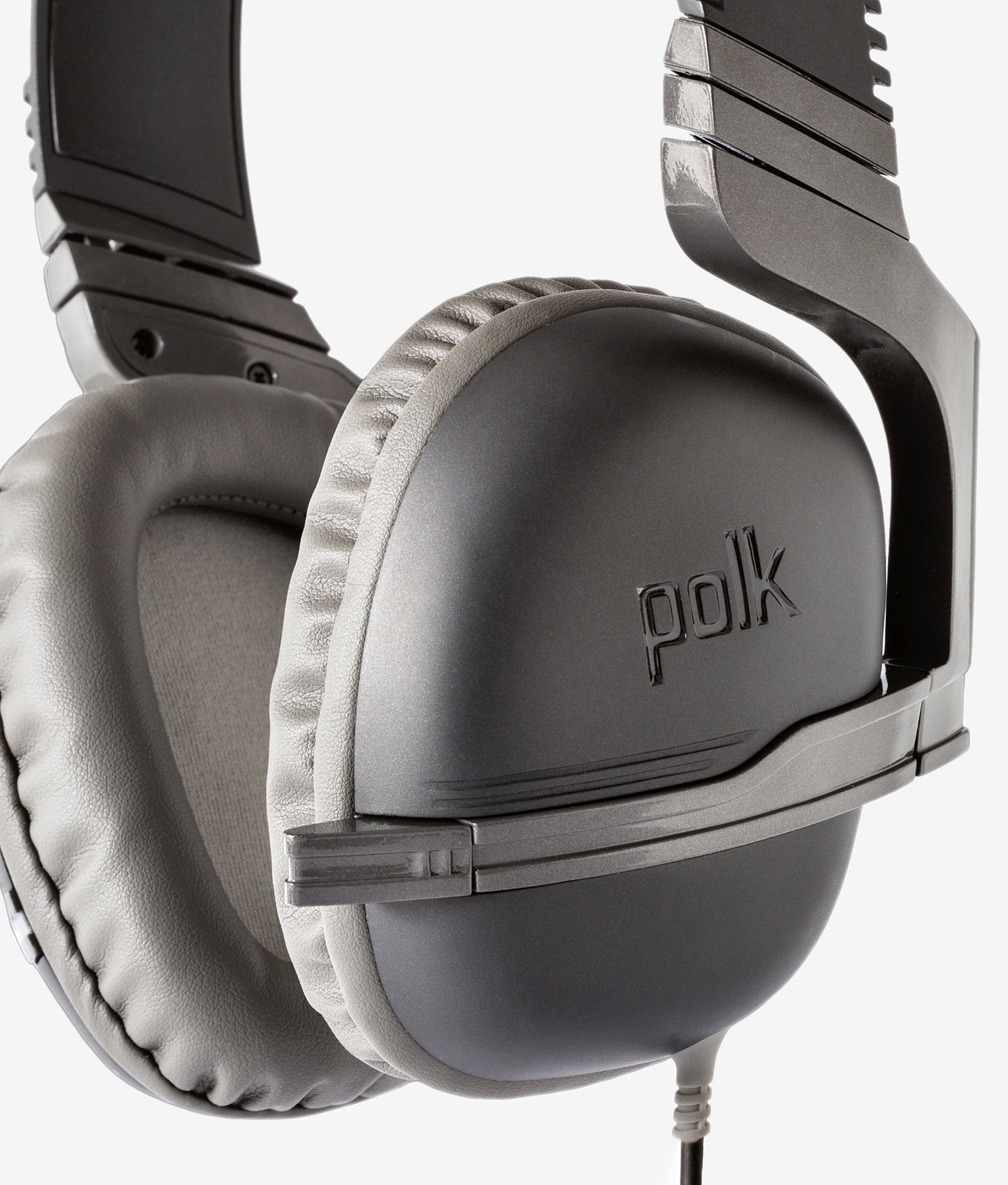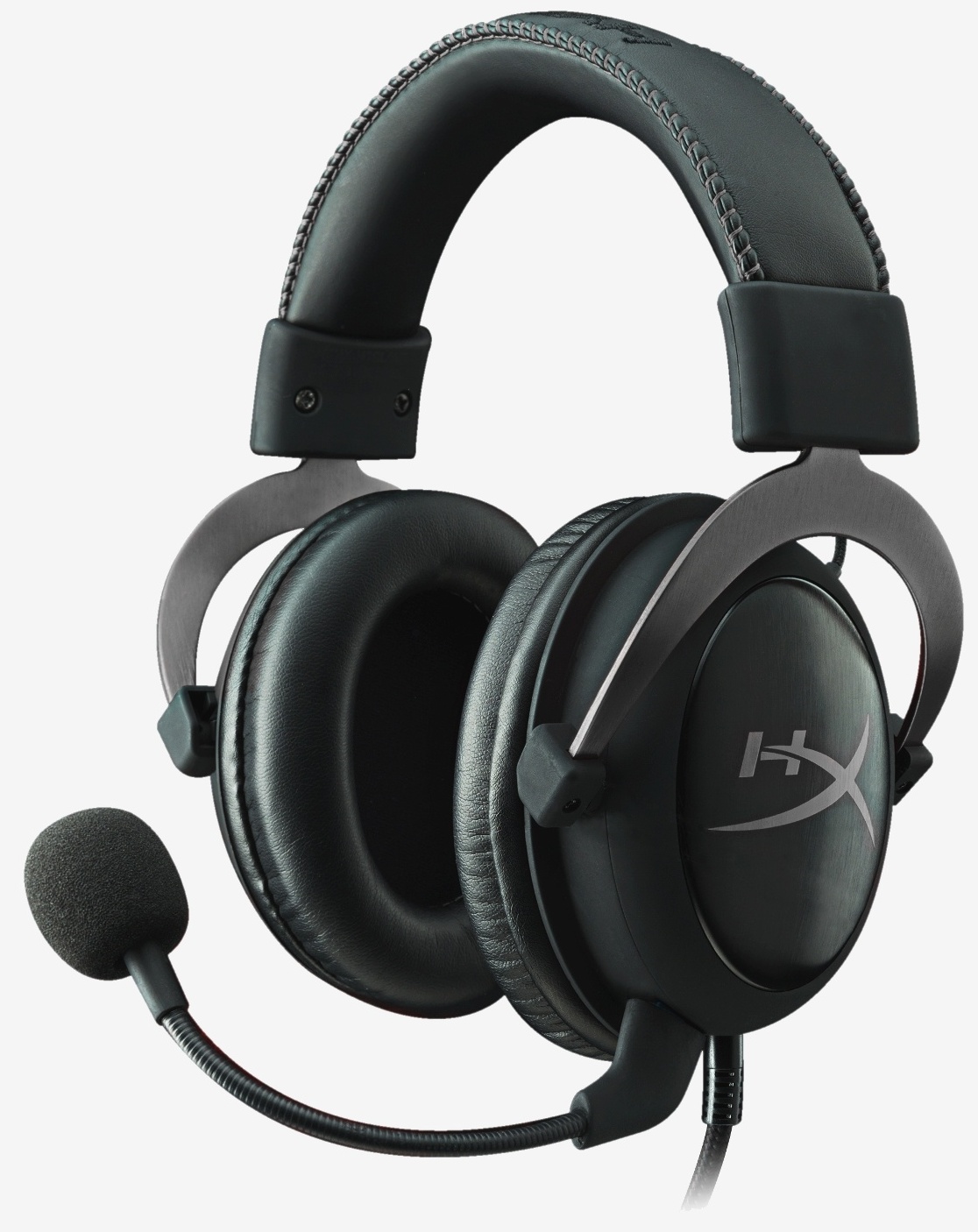Gigabyte, Polk, Kingston
Gigabyte Force H3X
Price: $80
The Gigabyte Force H3X is a large headset, much like the Logitech G430. The over-ear cups fit me well and yet I didn't like how they felt. Gigabyte came so close to getting this product bang on but we think that its frame falls short.
Although the headset sits nicely on your head and ears, the problem starts the second you move. Small, slow movements cause the Force H3X headset to wobble all over the place and this is where they go from being comfortable to annoying.
Part of the wobbling is caused by a design feature that is meant to make the headset fit better. Each cup can tilt a few degrees in any direction, which is great for improving the fit on a range of different head shapes, but without proper support it creates the wobble effect. To solve this issue the frame needs to apply more pressure.
The cups themselves are made out of a leatherette type material which are padded with soft foam. They don't feature any kind of passive noise-cancelling so you can still easily hear your surroundings. Each cup has been fitted with a 50mm driver and are sufficiently deep so your ears don't rub against the driver's protective cloth material. The drivers offer a frequency response of 20Hz-20KHz. There's 32 Ohms of impedance and the sensitivity rings in at 118dB while Gigabyte rates them for a maximum of 50mW.
Moving on, we find a nice 2m long flat black cable that ends with two gold-plated audio connections, one for the headphones and one for the mic.
Embedded in the left side of the headset is a retractable microphone. I prefer a retractable mic to the design used by Logitech for the G430, which just folds the mic away. The retractable design should make the Force H3X headset more comfortable to wear when watching movies or listening to music.
Unfortunately the mic isn't perfect. It doesn't get anywhere near your mouth and instead will only reach the cheek of most players. This is a real shame because we love everything else about it, particularly the quality of the flexible steel cord – just not the length.
Another issue we found with the Force H3X headset was the inline controller. Normally this is a feature that would score big points for a gaming headset, but the quality of this controller is questionable at best. Despite looking and feeling better than the controller found on the Logitech G430 headset, Gigabyte's doesn't work that well.
For starters, we had issues with crackling. As you move the slider up or down to set the preferred volume level the drivers in the headset crackle quite loudly. There is also too much play in the slider button and it's easy to move accidentally.
The biggest issue we found was when sliding it all the way up to maximum volume as the left driver would drop out completely. If we slide the volume just short of maximum the headset worked fine. It isn't clear if this is just an issue with our review sample or if this affects most Force H3X headsets.
The inline controller issues spoiled the Force H3X for us.
Audio Quality: The Gigabyte Force H3X does a decent job of making you forget all its shortcomings once you're distracted by a game. Its bass is respectable for being so far south of $100 and while it's plenty crisp, it does lack punch. We were expecting more out of the 50mm drivers – the Logitech G430's smaller 40mm drivers .
The higher frequencies are nice and clear and more importantly so are the mid tones. In-game character voices sound great and have real impact. This will make the Force H3X appealing to some gamers as you can clearly hear your enemy sneaking up on you in the midst of heavy gunfire and explosions.
The only downside to the Force H3X's performance was its mic. Audio just doesn't come through clearly on the other end and this could be due to its position which is a centimeter or so from reaching the side of your mouth. We suspect this will annoy many gamers.
Pros: The Force H3X has a lightweight design that looks sleek (though we tend to have a soft spot for all-black styling). It offers a retractable mic, lengthy flat cables and an affordable price tag.
Cons: The headset feels cheap and its wobbly ear cups are uncomfortable. Its control slider is either broken on our model or is simply of poor quality while its mic sounds bad next to the competition and it doesn't extend far enough in our opinion.
Polk Striker P1 Multiplatform
Price: $90
Polk likely needs no introduction for those of you interested in home audio as the company has been making quality speakers since the early 70s. However, we have no experience with Polk products when it comes to dedicated computer speakers and headsets.
On hand is the Polk Striker P1 Multiplatform gaming headset which retails for $90. As its name suggests, the set targets both PC and console gamers but Polk says that the Striker P1s will also hold up to playing your favorite music, movies and TV shows.
The Striker P1s are available in black, blue/cream and orange/cream. We have the latter for this roundup.
Compared to the Logitech G430 and Gigabyte Force H3X we just looked at, the Polk Striker P1 looks rather small and inadequate – such was our initial impression anyway. Fortunately, that notion went right out the door when we put the headset on. It's amazingly comfy.
The cups don't engulf our ears like the Logitech G430 but it doesn't seem as if they need to either. Whereas Gigabyte got the headband tension all wrong, Polk has nailed it and gamers will surely take comfort in that.
The ear cups tilt and swivel a few degree to help them suit a range of head shapes, yet despite their range of movement they feel firm once clamped on your head.
Polk attributes the Striker P1's comfort to the company's ProFit Comfort technology. This is a combination of a lightweight molded headband with a thick cushion and two-way pivoting ear cups with protein leather padding. Call it what you will, we just know it works really well.
Embedded in the headset are a pair of 40mm drivers using Polk's patented Dynamic Balance driver design process. Polk says this helps eliminate resonance and creates the Striker's game-changing sound. They are rated with the same 20Hz-20KHz frequency response as the Gigabyte and Logitech headsets while they also feature 32ohms of impedance.
Like the Gigabyte Force H3X, the Striker P1 features an embedded microphone in the left ear. The retractable omni-directional boom microphone comes with a 7cm extension that is similar to the design implemented by Gigabyte. Logitech's boom is 12cm long and reaches out in front of the player's mouth really well. It will be interesting to see how the shorter mic of the Striker P1 performs having already seen poor results with Gigabyte's solution.
Polk includes an inline volume control and mic mute switch. The design is simple, elegant and above all works exceptionally well. Polk was clever in how it connected the controller as well. Unlike the fixed inline controllers on Gigabyte and Logitech's headsets, Polk's controller can be removed.
It connects to the end of the main cord which is 90cm long. This may sound far away but with the cord hanging down out of the way the controller can sit right next to your keyboard for easy access rather than dangling in the air in front of you. There is an additional 1.2m cable that runs from the controller to the sound card and it splits the mic from the headphones.
Audio Quality: The Striker P1 might be Polk's budget headset but you wouldn't know it. Stereo audio came in clean, clear and loud when we played Call of Duty: Advanced Warfare, Alien: Isolation and The Crew. It's worth noting that the Striker P1 uses the same 40mm driver as the pricier 4 Shot model.
Quality-wise, Polk's Striker P1 smokes Gigabyte's Force H3X. The former set is cleaner and crisper across the range and its bass is on another level as well – even better than Logitech's G430.
All the headsets were tested listening to music from Spotify using the 'extreme' quality setting and we enjoyed listening to a range of tunes with the Striker P1. This may be the best choice for folks who listen to a ton of music.
Unfortunately, as we feared, the short mic boom did cause problems. It often produced muffled voice or simply wasn't loud enough. The quality was still better than what we experienced with the Gigabyte Force H3X, but not as good as the Logitech G430.
Pros: Amazing sound quality from a sub-$100 headset, thumping bass, extremely comfortable, nice and light, well designed inline control and flexible cable options.
Cons: Short mic causes voice to be muffled and quiet. Build quality is questionable with an all-plastic design and the orange/cream model we have looks a bit tacky.
Kingston HyperX Cloud II
Price: $100
Those willing to spend a little more on a gaming headset may be tempted by the Kingston HyperX Cloud II's brushed aluminum frame, accent stitching and overall impressive build quality.
The over-ear cups are similar to those found on the Polk Striker P1 and they are just as comfortable, though we do prefer the look and design of the HyperX Cloud II. It's probably the most professional looking headset in this roundup. Fortunately, it also has the audio quality to back it up.
Kingston has included a spare pair of ear cups which differ from the leatherette cups that come pre-installed. The alternate set has a soft microfiber-like material (possibly velour) and are padded with a firmer foam.
Included are a pair of 53mm drivers and when using the USB control box they support virtual 7.1 surround sound. These drivers offer a frequency response of 15Hz-25KHz. There's 60ohms of impedance and the sensitivity rings in at 98dB SPL/mW. On paper, this is the most capable headset in our roundup.
The ear cups have been constructed from plastic, though they have been given a nice rubberized finish along with a brushed aluminum insert that looks great.
Connecting the ear cups to the headband are brushed aluminum arms which are durable and stylish. The headband itself is padded with memory foam and wrapped in leatherette with attractive accent stitching.
At this point you won't have noticed the microphone and that is for a good reason... it isn't there yet. Kingston has gone with a detachable mic and we think this is a brilliant idea. As on the Logitech G430, the HyperX Cloud II's microphone can be folded or in this case bent away from the user when it's not needed.
However it can also be removed entirely and this is something we wished we could have done with the G430. Another advantage of the detachable mic is that Kingston has been able to make it rather long, certainly longer than the retractable versions that we have seen. Additionally, the company included a lot of foam over the mic which helps to reduce/eliminate breathing noises.
Under where the mic attaches to the headset you will find a nice thick sleeved cable that is about 100cm long. If you aren't going to use the USB sound controller then this cable isn't really long enough to reach your PC without an extension, unless you can plug it into your keyboard or something like that.
The USB cable with control box does add about 200cm more length which is ample to reach the computer or a USB hub. The control box allows gamers to mute the mic or adjust its volume as well as adjust the headphone volume and enable 7.1 audio. It also features a little clip on the back so you can attach it to your clothes.
Audio Quality: Getting the Kingston HyperX Cloud II set up is very easy as it is simply a matter of plugging in the USB to an available port and then connecting the headset via the jack to the USB controller. Once the propriety drivers are installed you are good to go. The control box looks pretty cool once powered on as the HyperX logo and 7.1 button light up red.
When pressed, the 7.1 button enables the virtual 7.1-channel surround sound. It's only being produced by two drivers but uses audio processing to mix the left and right channels in a surround sound-like way. The effect is cool but it certainly isn't anything like real 7.1-channel surround sound and it didn't add much more to the games we tried it with.
The control box itself is excellent, we just wish there was a way to get this level of functionality and still use our sound card rather than the USB sound, which keeps up with bass of the Polk Striker P1 but isn't as crisp or clear at the higher frequencies. Still, Kingston has managed to provide good sound quality overall.
The microphone also works well. It's very sensitive but that can be dialled down easily enough. Most importantly, voices come through clearly.
Pros: The HyperX Cloud II offers excellent sound quality and a top-notch mic that is both flexible and detachable while still managing to be comfortable and look professional.
Cons: Kingston's headset isn't as strong as Polk's when listening to music because it can't handle higher frequencies quite as well.
